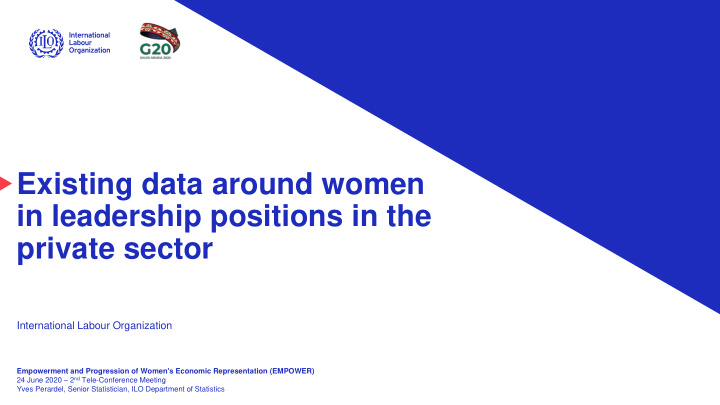



Existing data around women in leadership positions in the private sector International Labour Organization Empowerment and Progression of Women's Economic Representation (EMPOWER) 24 June 2020 – 2 nd Tele-Conference Meeting Yves Perardel, Senior Statistician, ILO Department of Statistics
2 Content Definitions SDG 5.5.2 - Female share of employment in managerial positions Leadership positions by economic activity Leadership positions by economic activity in the private sector Existing microdata shared with the ILO and data gaps Advancing social justice, promoting decent work
3 Definitions Employment : persons doing, at least for one hour, an activity for pay or profit in a reference week. ISCO-08 : International Standard Classification of Occupations (latest revision in 2008). Among the 10 major groups, category “01” is for the managerial positions (Managers). It is considered the highest category in ISCO. ISIC Revision 4 : International Standard Industrial Classification of all Economic Activities Revision 4. Advancing social justice, promoting decent work
4 The share of women in middle and senior management positions is below 50 per cent in all countries with available data SDG 5.5.2 (%) 45.0 40.0 SDG indicators receive a 35.0 particular attention 30.0 SDG 5.5.2 is an adequate 25.0 indicator for the objectives of 20.0 EMPOWER 15.0 Data is available for 16 10.0 countries 5.0 0.0 Advancing social justice, promoting decent work Source: National labour force surveys; latest year available.
5 The average share of women in leadership positions stands at 38 per cent Share of women in managerial positions among total managerial positions by economic activity (%) With considerable 70 60 variations across sectors: 50 Below 14 per cent in the 40 construction sector 30 Well above 50 per cent in human 20 health and social work (67%), 10 education (61%) and activities of 0 Total Q. Human health and social work P. Education T. Activities of households as S. Other service activities R. Arts, entertainment and K. Financial and insurance O. Public administration and I. Accommodation and food M. Professional, scientific and L. Real estate activities N. Administrative and support G. Wholesale and retail trade J. Information and communication H. Transportation and storage C. Manufacturing A. Agriculture; forestry and fishing D. Electricity; gas, steam and air E. Water supply; sewerage, B. Mining and quarrying F. Construction households as employers of waste management domestic personnel (60.5%) and service activities technical activities service activities conditioning supply recreation activities employers other service activities (51.5%) defence activities Data based on 13 countries Advancing social justice, promoting decent work Source: National labour force surveys; latest year available.
F. Construction 6 E. Water supply; sewerage, waste management The overall share of women in leadership positions is slightly B. Mining and quarrying Share of women in managerial positions in the private sector D. Electricity; gas, steam among total managerial positions in the private sector (%) and air conditioning supply A. Agriculture; forestry and fishing H. Transportation and Source: National labour force surveys; latest year available. storage C. Manufacturing G. Wholesale and retail trade J. Information and communication N. Administrative and support service activities L. Real estate activities M. Professional, scientific and technical activities I. Accommodation and food service activities R. Arts, entertainment and recreation O. Public administration and defence K. Financial and insurance activities S. Other service activities P. Education lower in the private sector T. Activities of households as employers Q. Human health and social work activities Total 70 60 50 40 30 20 10 0 Advancing social justice, promoting decent work Distribution across sectors Data based on 9 countries points lower than in the follows a similar pattern Overall 1.3 percentage public sector
7 Existing data shared with the ILO and data gaps 9 countries have no data gap . These countries share their labour force survey microdata and all the needed variables are available. 8 countries share their microdata but some variables are missing (ISCO-08, ISIC Rev. 4 or the variable to identify private sector) 6 countries do not share microdata and therefore the last 2 indicators cannot be produced for the time being. Advancing social justice, promoting decent work Source: National labour force surveys; latest year available.
8 Stock-take report on data availability and preliminary findings of women in managerial positions – Outline 1. Data situation among G20 Members a. Definition of key labour market indicators b. Sources of information c. SDG indicator 5.5.2 “Proportion of women in managerial positions” d. Current State of Play 2. Key findings from the data a. Progress or regress towards SDG 5 b. Variation between economic sectors c. Differences between private and public sector employment 3. Conclusion
9 Thank you for your attention Advancing social justice, promoting decent work
Recommend
More recommend